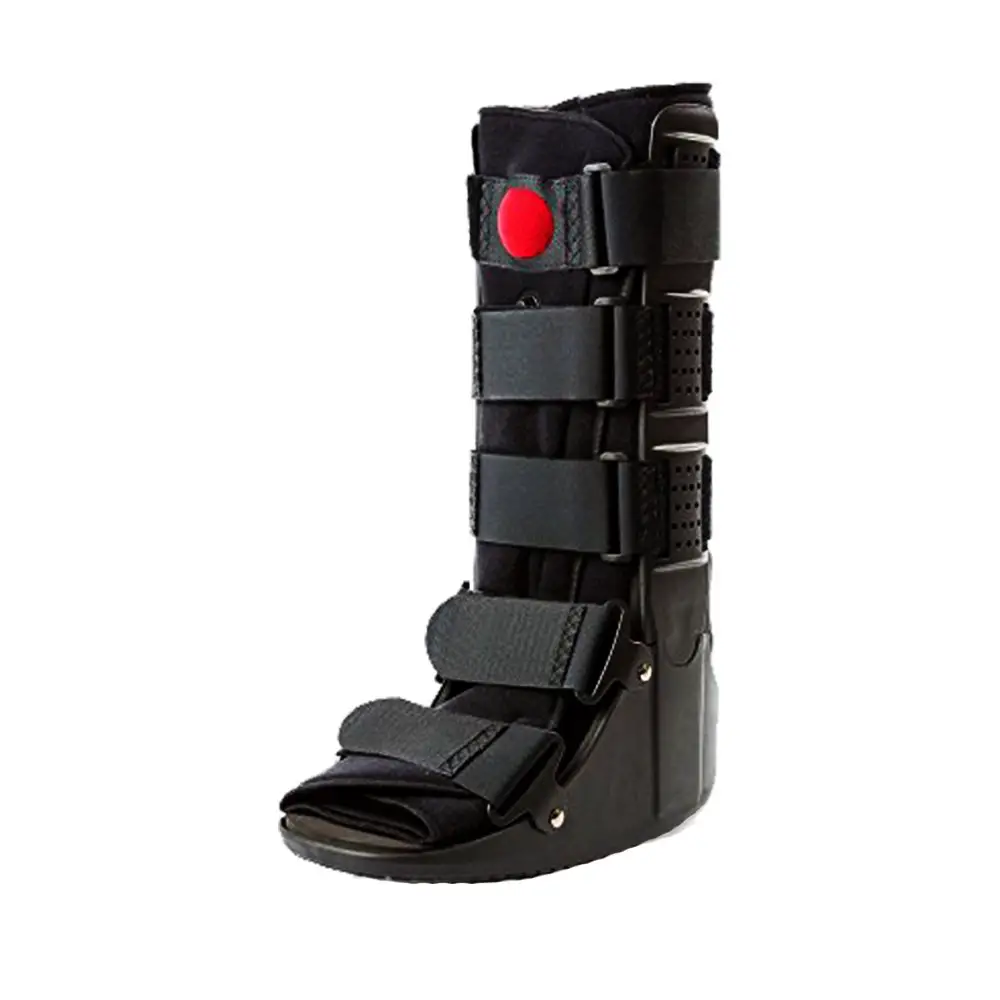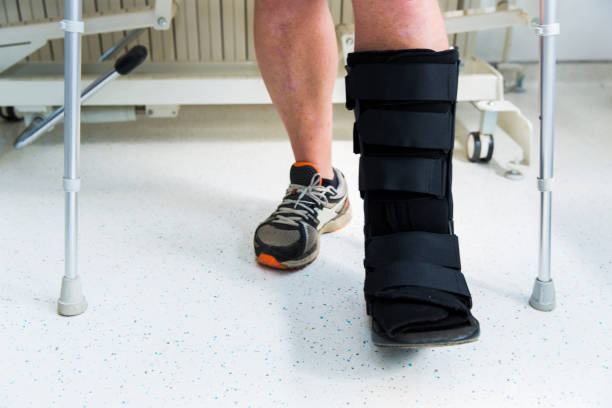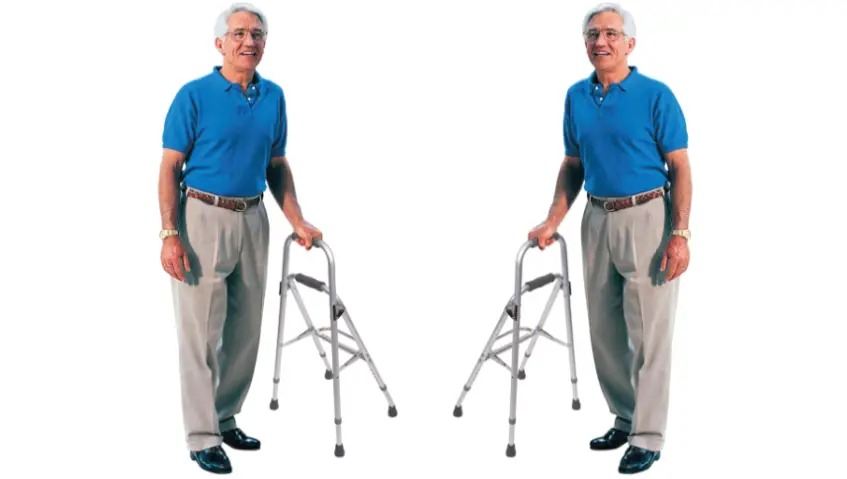There are times that you might need to use two mobility devices at the same time when you suffer from a broken leg, foot, or any type of leg injury.
This is done to help facilitate quick recovery and give you the best healing result.
The two common mobility devices that patients utilize at the same time to ease their mobility are the walking boot and crutches.
In this article, you’ll learn more about these two devices, why it is important to use both after a leg injury, and how to effectively walk in both mobility devices.
Table of Contents
- What is a Walking Boot?
- What are Crutches?
- Why You Should Walk in a Walking Boot with Crutches
- How to walk in a Walking Boot with Crutches (Comprehensive Guide)
- How to Walk in a Walking Boot with Crutches (Video)
What is a Walking Boot?
A walking boot is commonly referred to as an orthopedic shoe. It is a type of medical shoe that is designed to protect the leg, ankle, or foot from any form of injury a person might suffer from.

Such injury includes shin splint, sprains, tendon injuries, and post-surgery injury.
Related: How to Comfortably Use Crutches at School
Importance of Using a Walking Boot
- It helps to protect the foot and ankle, especially when you suffer from a broken foot or leg
- A walking boot helps to provide stability to your foot as you walk around
- It allows you to safely put weight on the injured foot without causing any damage or severe pain to the foot
- It helps to hasten your recovery and allows the injury to heal faster
What are Crutches?
Crutches are one of the simplest mobility devices used by people who are unable to walk.
Such people include those who have injuries, the sick, or people who are recuperating after an accident or surgery.
It is a mobility aid that can be used short-term by patients to aid rapid recovery.
Crutches help to take the pressure of your bodyweight off your injured leg by using your upper body strength for mobility.
Benefits of Using Crutches
- Crutches are simple mobility devices that help to transfer your body weight from your legs to your arms and torso. This helps to remove the pressure of your body weight from your injured leg
- They help with balancing and stability, especially if you suffer from a leg injury or just had a surgery
- They also help to aid quick ambulation
Related: How to Make Crutches without Wood (DIY)
Why You Should Walk in a Walking Boot with Crutches
It’s been a debatable topic over the years whether you can walk in a walking boot with crutches or not.
Some physiotherapists are of the opinion that the use of crutches is not necessary, while others posit that crutches are needed to be used alongside the walking boot, especially if the injury is severe.
In lieu of the above, the following are some of the reasons why you should use crutches alongside your walking boot.
- Since the major aim of the walking boot is to take excessive weight off the injured foot to enable you feel better, the crutches help to make the process effortless by giving you something to lean on while walking
- Crutches serve as assistive mobility devices that help the walking boot speed up your recovery
- They both help to keep the patients in the upright position as they learn how to walk again after sustaining an injury or undergoing surgery
- They are the best combo for short-term injury because they help to facilitate quick recovery when they’re used effectively
- Walking with crutches and walking boot will give you a great level of independence and allow you to move around quickly and effortlessly, especially if you can’t walk with only the boots
How to walk in a Walking Boot with Crutches (Comprehensive Guide)

Prepare the Boot and Secure Your Foot
Before you can walk in a walking boot, there are different processes you must undergo to ensure that the boot fits you properly. They include the following.
- First, you must make sure that any shoe or footwear that you’ll be wearing on your uninjured leg is roughly the same height with your walking boot. This is crucial to ensure that there is an even distribution of your body weight. This is made easier with the adjustable heel lift that some walking boots have
- Gently open the walking boot and slid the injured foot inside the boot
- Adequately secure your foot in the boot by closing the strap at the front and top of the boot
- If the boot feels too tight, pump the belly at the top to release the tightness and make the boot more secure. Once that’s done, you’re good to start walking with your boot
Related: How to Make Crutches Out of Homemade Items (DIY)
Walk in the Walking Boot with Your Crutches
- Before you start using the crutches alongside the walking boots, ensure that your crutches have paddings at the top and at the handle bars. Don’t add towel or anything extra to the paddings to prevent discomfort
- Make sure your crutches have rubber tips
- Adjust the crutches to your height. The top of the crutches should be 2 to 3 fingers below your armpit
- Make sure that the handle is placed up to the level of your wrist when your arm is straight down
- Place the two crutches in front of you in a way that our crutches and your injured leg are in the tripod position
- Before you start walking, ensure that the floor is clean, dry, and clutter-free
- When you begin to walk with the crutches alongside your boots, look forward, don’t look down on your feet
- Let your hands carry your body weight, not the armpits
- Hold your crutches firmly between your rib cage and your arms
- Always place your crutches a few steps ahead of your body
- Then step forward with your uninjured leg before following it with the injured one
It’s pertinent to consult your doctor or physiotherapist on how much weight you can put on your injured leg while using walking boots with crutches.
Sometimes, the nature of your injury will also help the doctor to determine if the weight-bearing capacity on your injured leg will be partial, full, or non-weight-bearing.




